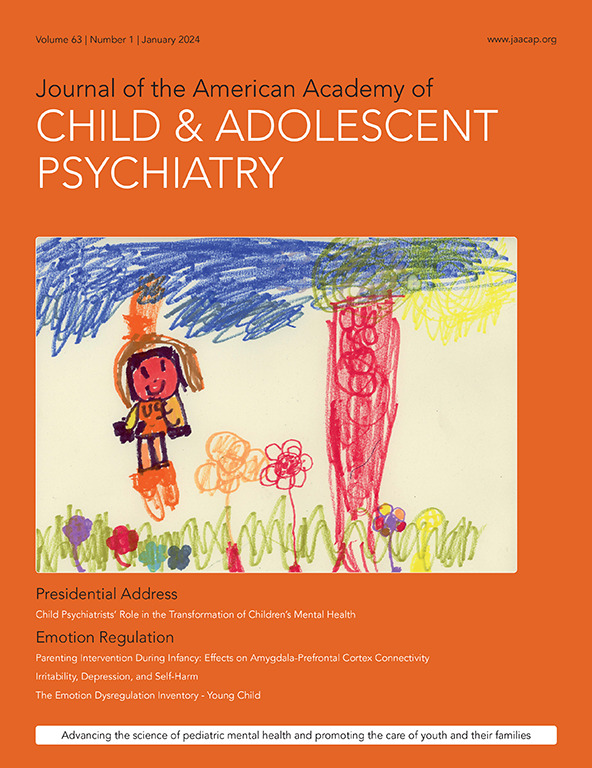Does State-Level Structural Racism Impact Risk for Suicide Attempts Among US Adolescents Across Race And Ethnicity?
IF 9.2
1区 医学
Q1 PEDIATRICS
Journal of the American Academy of Child and Adolescent Psychiatry
Pub Date : 2024-12-20
DOI:10.1016/j.jaac.2024.09.012
引用次数: 0
Abstract
OBJECTIVE Our study examined the association between state-level structural racism and past year rates of suicide ideation (SI) and suicide attempts (SA) among non-Hispanic Black, Hispanic, and non-Hispanic White adolescents. METHOD This secondary analysis used state- and individual-level linked data combining multiple years i.e., 2011-2019, of the Youth Risk Behavior Surveys, the 2019 American Community Survey, and the 2019 state-level Structural Racism Index (SRI), a composite measuring state-level Black-White (B-W) and Hispanic-White (H-W) racial inequities across five domains: residential segregation, incarceration rates, educational attainment, economic indicators, and employment status. A series of generalized estimating equations were used to examine the association between structural racism and past-year SI and past-year SA, with race/ethnicity as a moderator, adjusting for state- and individual-level covariates, among U.S. adolescents. RESULTS Negative associations were observed between B-W SRI with SI (Adj. b [95% CI] = -0.011 [-0.017, -0.003], p =.004), and SA (-0.011[-0.018, -0.004], p = .002), as well as between H-W SRI with SI (-0.008 [-0.016, -0.0002], p = .044), and SA (-0.011 [-0.018, -0.004], p = .001). These associations were significantly modified by race and ethnicity for both B-W SRI and H-W SRI. Both Black (SI= -0.011 [-0.02, -0.002]; SA= -0.011 [-0.019, -0.004]) and Hispanic (SI = -0.097 [-0.011,-0.004]; SA = -0.011 [-0.018, -0.004]) adolescents living in states with higher structural racism had lower rates of past-year SI and SA relative to White adolescents. Exploratory analyses identified a negative association between the residential segregation index and past-year SI and SA among Black and Hispanic adolescents. Meanwhile, a positive association emerged between B-W incarceration index and past-year SA, though not past-year SI, among Black adolescents. CONCLUSION Adolescents in states with higher SRI were at lower risk for past-year SI and SA. Racial inequities across various institutions may differentially influence suicide-related risk among adolescents. Structural racism may play an important role in conferring risk for SI and SA, and its impact may vary across Black, Hispanic, and White adolescents. Attending to institutional level markers of racism may help improve the cultural responsiveness of youth suicide prevention strategies.州一级的结构性种族主义是否影响美国青少年跨种族和民族的自杀企图风险?
目的:本研究探讨了非西班牙裔黑人、西班牙裔和非西班牙裔白人青少年中州一级结构性种族主义与过去一年自杀意念(SI)和自杀企图(SA)率之间的关系。该二次分析使用了州和个人层面的关联数据,结合了多年(即2011-2019年)的青年风险行为调查、2019年美国社区调查和2019年州一级结构性种族主义指数(SRI),该指数是一种综合衡量州一级黑人-白人(B-W)和西班牙裔-白人(H-W)种族不平等的五个领域:居住隔离、监禁率、受教育程度、经济指标和就业状况。在美国青少年中,使用一系列广义估计方程来检验结构性种族主义与过去一年的SI和过去一年的SA之间的关系,其中种族/民族作为调节因子,调整了州和个人水平的协变量。结果b - w SRI与SI (Adj. b [95% CI] = -0.011[-0.017, -0.003], p = 0.004)、SA (-0.011[-0.018, -0.004], p = 0.002)、H-W SRI与SI (-0.008 [-0.016, -0.0002], p = 0.044)、SA (-0.011[-0.018, -0.004], p = 0.001)呈负相关。在B-W和H-W SRI中,这些关联被种族和民族显著改变。均为Black (SI= -0.011 [-0.02, -0.002];SA = -0.011[-0.019, -0.004])和西班牙(SI = -0.097 (-0.011, -0.004);SA = -0.011[-0.018, -0.004]),与白人青少年相比,生活在结构性种族主义较高的州的青少年过去一年的SI和SA发生率较低。探索性分析发现,在黑人和西班牙裔青少年中,居住隔离指数与过去一年的SI和SA之间存在负相关。同时,在黑人青少年中,B-W监禁指数与过去一年的SA呈正相关,但与过去一年的SI无关。结论在SRI较高的州,青少年过去一年发生SI和SA的风险较低。不同机构的种族不平等可能对青少年自杀相关风险产生不同的影响。结构性种族主义可能在赋予SI和SA风险方面发挥重要作用,其影响在黑人,西班牙裔和白人青少年中可能有所不同。关注制度层面的种族主义标记可能有助于提高青少年自杀预防策略的文化响应性。
本文章由计算机程序翻译,如有差异,请以英文原文为准。
求助全文
约1分钟内获得全文
求助全文
来源期刊
CiteScore
21.00
自引率
1.50%
发文量
1383
审稿时长
53 days
期刊介绍:
The Journal of the American Academy of Child & Adolescent Psychiatry (JAACAP) is dedicated to advancing the field of child and adolescent psychiatry through the publication of original research and papers of theoretical, scientific, and clinical significance. Our primary focus is on the mental health of children, adolescents, and families.
We welcome unpublished manuscripts that explore various perspectives, ranging from genetic, epidemiological, neurobiological, and psychopathological research, to cognitive, behavioral, psychodynamic, and other psychotherapeutic investigations. We also encourage submissions that delve into parent-child, interpersonal, and family research, as well as clinical and empirical studies conducted in inpatient, outpatient, consultation-liaison, and school-based settings.
In addition to publishing research, we aim to promote the well-being of children and families by featuring scholarly papers on topics such as health policy, legislation, advocacy, culture, society, and service provision in relation to mental health.
At JAACAP, we strive to foster collaboration and dialogue among researchers, clinicians, and policy-makers in order to enhance our understanding and approach to child and adolescent mental health.

 求助内容:
求助内容: 应助结果提醒方式:
应助结果提醒方式:


